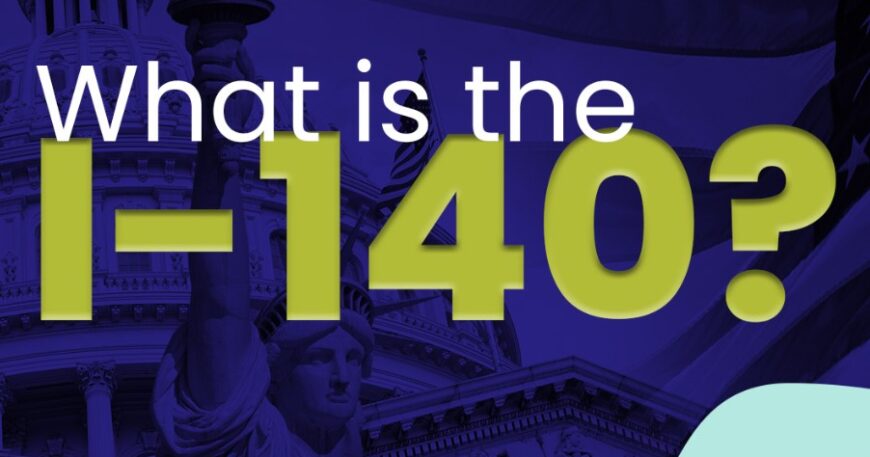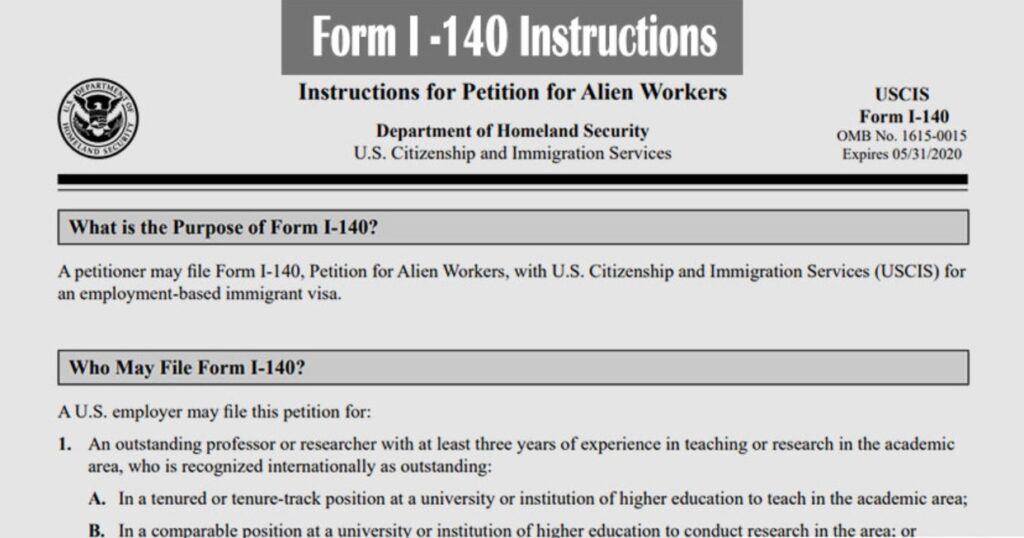Introduction:
The I-140 form is a key document in the U.S. immigration process for employment-based green card petitions. Understanding how to file this form, where to submit it, and what fees are involved can be overwhelming for many applicants.
In this article, we’ll break down everything you need to know about the I-140 form, from filing instructions to associated costs, so you can confidently navigate the process.
What is the I-140 Form?
The I-140 form is a petition for an immigrant worker, typically filed by a U.S. employer on behalf of a foreign worker seeking permanent residency.
The form serves as a request to the U.S. government to approve the foreign worker’s eligibility to apply for a green card.
Once approved, the worker can proceed with adjusting their status or apply for an immigrant visa.
Who Needs to File an I-140 Form?
If you’re a foreign worker in the U.S. seeking a green card, your employer needs to file the I-140 form for you.
The categories for the I-140 include:
- EB-1: Priority workers (including researchers, executives, and people with extraordinary abilities)
- EB-2: Professionals with advanced degrees
- EB-3: Skilled workers and other workers
How to File an I-140 Form
Filing the I-140 is a crucial step in the process of obtaining a green card. Here’s how to file it:
- Complete the Form: The form requires detailed information about the worker, the job offer, and the employer.
- Include Supporting Documents: This includes evidence of the worker’s qualifications and the employer’s ability to pay the offered salary.
- Sign and Submit: Ensure all fields are completed correctly, sign the form, and send it to the designated address (discussed below).
Tips for Filing I-140 Form:
- Ensure your information is accurate and complete to avoid delays.
- Double-check all supporting documentation to prevent requests for additional evidence (RFE).
I-140 Form Filing Fee
The standard filing fee for the I-140 form is $700.
However, keep in mind that this fee can vary depending on the type of petition and whether you opt for premium processing (discussed later).
I-140 Form Premium Processing Fee
Premium processing for I-140 petitions allows expedited processing, guaranteeing a decision within 15 calendar days.
The current fee for premium processing is $2,500.
While it’s not required, premium processing is a popular option for employers and workers who want to speed up the approval process.
Where to File the I-140 Form?
The I-140 form must be filed with U.S. Citizenship and Immigration Services (USCIS).
Where you file the form depends on the petitioner’s location. You can check the USCIS website for specific filing addresses.
The common filing locations include:
- Nebraska Service Center
- Texas Service Center
I-140 Form Filing Address
To find the correct filing address, refer to the USCIS website or the official instructions for the I-140 form.
Tip: Using the wrong address can delay processing, so double-check before sending your application.
I-140 Form Filing Process Step-by-Step
- Prepare the Required Documents:
- Labor certification (if applicable)
- Proof of qualifications
- The employer’s financial ability to pay
- Complete the Form I-140
- Pay the Filing Fee
- Submit the Form and Wait for USCIS Decision
Common Mistakes to Avoid When Filing I-140 Form
Filing errors can lead to significant delays or even result in the denial of the petition.
Here are some common mistakes to avoid:
- Incomplete or inaccurate forms
- Failing to provide necessary evidence
- Sending documents to the wrong USCIS address
- Not paying the required fee
- Filing after the deadline
Processing Times for I-140 Form
Processing times for the I-140 form can vary.
Typically, it takes about 6 to 12 months for USCIS to process a standard I-140 petition.
Premium processing reduces this time to just 15 calendar days.

How Long is the I-140 Form Valid For?
Once approved, the I-140 is valid indefinitely, but it’s essential to note that it is tied to the worker’s employment.
If the worker changes employers, the I-140 petition may no longer be valid unless the new employer files a new I-140 petition.
What Happens After Filing the I-140?
After submitting your I-140 form, you will receive a receipt notice from USCIS.
If your petition is approved, USCIS will send you a notice of approval.
If there are any issues or requests for more information, USCIS may issue a Request for Evidence (RFE).
I-140 Approval Notice: What’s Next?
After I-140 approval, if you are in the U.S., you can file for adjustment of status (Form I-485) to become a permanent resident.
If you are outside the U.S., you will need to go through consular processing for an immigrant visa.
Frequently Asked Questions (FAQs) about I-140
What is the I-140 form used for?
U.S. employers use the I-140 form to sponsor a foreign worker for a green card, typically in employment-based immigration categories like EB-1, EB-2, and EB-3.
How much does the I-140 filing fee cost?
The standard I-140 filing fee is $700. Additional fees may apply for premium processing and other services.
How long does it take for I-140 approval?
The typical processing time for an I-140 petition is between 6 and 12 months unless premium processing is used, which guarantees a decision within 15 calendar days.
Can I file the I-140 form myself?
No, the I-140 must be filed by your U.S. employer. It’s an employment-based petition.
What happens if my I-140 gets denied?
If your I-140 is denied, you may be able to file an appeal or reapply with additional evidence.
Where do I send the I-140 form?
The I-140 form must be sent to the USCIS service center that is closest to your location. Always check the USCIS website for the latest filing address.
Conclusion
Filing the I-140 form is a critical step in securing permanent residency through employment in the United States.
By understanding the filing process, fees, and common mistakes to avoid, you can navigate the system more effectively.
Whether you choose standard processing or opt for premium processing to speed up the decision, ensuring accuracy in your filing is key to a successful petition.
Additional Resources for Filing I-140
Navigating the I-140 form process can be daunting, but there are plenty of resources available to assist you along the way.
Here are some reliable sources you can use to ensure that you’re filling out your I-140 form correctly:
- USCIS Website: The official USCIS website is your best friend when it comes to filing the I-140.
You can find the most up-to-date instructions, filing addresses, and processing times on this page. - Immigration Attorneys: Hiring an experienced immigration attorney can make the process smoother.
They can help you avoid costly mistakes and ensure that your petition is filed correctly. - Immigration Forums and Communities: Online communities, such as Reddit or specialised immigration forums, can offer insights from others who have gone through the I-140 process.
The Role of an Immigration Attorney in Filing I-140
While it’s possible to file the I-140 form without an attorney, many applicants opt to hire one to reduce the likelihood of errors and complications.
An immigration attorney will:
- Help you gather and organize the necessary evidence
- Ensure that the petition is filled out correctly
- Advise on strategies to strengthen your case
- Represent you in case of an RFE (Request for Evidence)
Having an attorney on board can be especially beneficial if you have a complicated case or unusual circumstances.
What Happens if My Employer Withdraws the I-140 Petition?
In some cases, employers may choose to withdraw an I-140 petition after it has been filed.
If the petition is withdrawn before it is approved, the case will be cancelled, and the worker’s path to a green card will be blocked.
However, if the I-140 is approved and the worker changes employers, the approved petition can sometimes be transferred.
Under the AC21 Act, workers with approved I-140 petitions can switch employers, provided they meet certain conditions, such as the job being in the same or similar field.
How to Track Your I-140 Status
Once you’ve submitted your I-140 form, you can track its progress through the USCIS Case Status Online Tool.
Enter the receipt number from your I-140 notice to get real-time updates on the status of your case.
Impact of I-140 Approval on Your Green Card Process
If your I-140 petition is approved, it’s a significant milestone toward obtaining your green card.
For those already in the U.S., an approved I-140 means you can file for adjustment of status (Form I-485).
For those outside the U.S., it enables consular processing and an immigrant visa interview at a U.S. consulate.
Approval of your I-140 allows you to move forward with obtaining lawful permanent residency, which provides long-term security in the U.S.
Tips for a Successful I-140 Petition
To improve your chances of I-140 approval, here are some practical tips:
- Complete the Form Accurately: Ensure all fields are filled out correctly to avoid delays.
- Submit Complete and Credible Evidence: Whether it’s degrees, work experience, or a job offer letter, the evidence must support your eligibility.
- Follow the Instructions: Always read and adhere to the USCIS instructions carefully.
- Consider Premium Processing: If you want to expedite your petition, the $2,500 premium processing fee may be worth it.
Final Thoughts on the I-140 Form
The I-140 form is one of the most critical documents in the employment-based green card process.
From gathering the necessary paperwork to filing the form with USCIS, understanding each step will help you successfully move toward your goal of permanent residency.
Whether you are a foreign worker or an employer looking to sponsor someone, navigating the I-140 filing process with confidence will help you avoid common pitfalls and save time.
With the proper knowledge and preparation, the process can be far less stressful than it may initially seem.
So, take your time, do your research, and make sure every detail is in order. You’ve got this!

Common I-140 Petition Denials and How to Avoid Them
It’s essential to understand why I-140 petitions are sometimes denied, so you can avoid mistakes that can lead to denials.
Here are some of the common reasons for I-140 denials and tips on how to avoid them:
- Lack of Proper Documentation:
The most common reason for denial is the lack of sufficient evidence to support the petition.
Ensure that all required documents, such as proof of qualifications, employment offer letters, and evidence of the employer’s financial stability, are included and well-documented. - Failure to Meet Eligibility Requirements:
If the worker doesn’t meet the specific requirements of the visa category (e.g., EB-1, EB-2, or EB-3), the petition may be denied.
Double-check the eligibility criteria for the specific category to avoid being rejected unnecessarily. - Errors in the I-140 Form:
Simple mistakes, such as missing signatures, incorrect information, or incomplete fields, can cause delays or denials.
Always review the form thoroughly and consider having someone else double-check it before submission. - Employer’s Ability to Pay:
For many employment-based green card categories, USCIS requires proof that the employer has the financial capability to pay the offered wage.
Be sure to submit clear and sufficient documentation of the employer’s financial standing.
Requesting Additional Evidence (RFE) for I-140
In some cases, USCIS may issue a Request for Evidence (RFE) to clarify certain aspects of the petition.
If you receive an RFE, it means that USCIS believes some part of your application requires further documentation.
Here’s how to handle an RFE:
- Read the RFE Carefully:
The RFE will specify what additional information is needed. - Gather the Required Documents:
Collect the requested evidence, whether it’s more detailed proof of your qualifications, job offer, or financials. - Submit the Documents Promptly:
Follow the instructions on the RFE and submit the requested evidence by the deadline.
Tip: If you fail to respond to an RFE promptly or provide insufficient evidence, your petition may be denied.
What Happens After Your I-140 is Denied?
If your I-140 is denied, don’t panic! You may still have options to fix the situation.
Here are some things you can do after an I-140 denial:
- Appeal the Decision:
You can appeal a denied I-140 petition to the Administrative Appeals Office (AAO) within 30 days of the decision.
Be prepared to present additional evidence and make a compelling case. - File a New I-140 Petition:
If you believe there was a mistake or new evidence has come to light, you can file a new petition.
This may require addressing the reasons for the previous denial. - Consider Other Visa Options:
If the I-140 denial was due to specific visa category issues, there may be other visa options available that you can pursue.
What to Do After I-140 Approval: Adjustment of Status or Consular Processing
After your I-140 is approved, it’s time to move forward with obtaining your green card.
There are two main paths, depending on whether you are inside or outside the U.S.:
- Adjustment of Status (Form I-485):
Suppose you are already in the U.S. on a valid non-immigrant visa. In that case, you can apply for adjustment of status (Form I-485) to transition from your current status to permanent resident status.
This process may include biometrics, an interview, and a notification of approval. - Consular Processing:
If you are outside the U.S., you will need to go through consular processing at a U.S. consulate in your home country.
This includes submitting the required forms, attending an interview, and waiting for approval before you can enter the U.S. as a permanent resident.
I-140 Portability: Changing Employers After I-140 Approval
Under the American Competitiveness in the 21st Century Act (AC21), certain workers with an approved I-140 can switch employers without jeopardizing their green card process.
Here’s how I-140 portability works:
- Eligibility Requirements:
The worker must have an I-140 approved for at least 180 days, and the new job must be in the same or a similar field. - Filing a New I-140 Petition:
The new employer must file a new I-140 petition on behalf of the worker.
However, the worker can keep their priority date from the previous I-140 petition, which can help avoid delays.
Tip: If you’re considering changing employers, consult an immigration attorney to ensure your I-140 remains valid and doesn’t negatively impact your green card application.
Conclusion: Mastering the I-140 Filing Process
Successfully navigating the I-140 filing process is a key step toward securing a green card through employment.
By understanding the form, the filing fees, and the process involved, you’ll be in a stronger position to ensure your petition is handled smoothly.
Whether you’re applying for the first time or dealing with an RFE, take the time to follow the instructions and consult experts carefully if needed.
With thorough preparation and attention to detail, you can avoid common pitfalls and move forward confidently with your green card journey.
Remember, the I-140 form is just one part of the process, but it’s an essential one, so make sure you do it right the first time.
Contact Syed Professional Service for Expert Guidance on Your I-140 Form
The I-140 form, also known as the Immigrant Petition for Alien Worker, is a crucial step in obtaining a U.S. Green Card. An employer typically files it on behalf of a foreign worker to help them obtain permanent residency in the country. If you’re navigating this complex process, Syed Professional Service can help.
Syed Professional Service specialises in immigration matters, and their team of experts can guide you through every aspect of the I-140 process. They will help ensure that your petition is completed accurately, meets all the requirements, and is submitted on time. They can also help you understand which category of the I-140 you qualify for, whether it’s based on employment, extraordinary ability, or other criteria.
By contacting Syed Professional Service, you’re taking a proactive step to ensure that your I-140 petition is handled with care and expertise, giving you the best chance for success.





